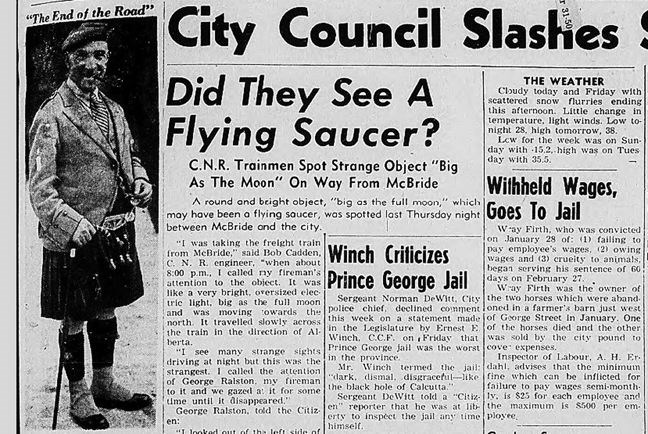This week in Prince George history, April 24-30:
April 30, 1919: A group of returned First World War veterans smashed buildings and drove several people - including a former police chief and several German residents - out of town during a riot on April 24.
"Damage to the Arcade building estimated at $2,000, Max Schenk's real estate office was wrecked, the interior of Conrad Reinharz's office suffered a like fate and a plate glass window demolished in the Princess block. This summerizes the damage wrought Thursday (April 24, 1919) night when a demonstration led by returned soldiers and civilians finally settled down," The Citizen reported.
A letter sent to city council, and published in The Citizen, by Joseph Tadin allegedly discredited local police chief constable Alex Steward -a veteran. This prompted a special meeting of veterans on Thursday night, The Citizen reported, where the group decided to order Tadin, the former chief constable Dolan, and several German residents to leave town the following day.
However, some members of the group gathered outside the Arcade building around midnight.
"Mayor Carney, who had arrived on the scene, states that the first stone was hurled by a German resident of this city. A perfect fusilade of rocks and missiles of all kinds followed and the destruction of the interior of the building was rapid and complete," The Citizen reported. "The demolition of Max Schenk's office across the street quickly followed, and the crown then proceeded to Conrad Reinharz's office in the Princess block, where the fixtures were broken up and the safe rolled into the street."
Tadin's business partner, Martin Zadelovitch, said their business was looted during the riot and clothes, blankets, jewelry and provisions were stolen.
"Tadin, Schenk, Reinharz and ex-chief Dolan did not question the order to depart from hence, and without waiting for trains took a tie-pass early Friday (April 25) morning with their faces to the east," The Citizen reported. "Also a number of suspicious characters believed by the police to be bootleggers were given running orders by the authorities."
Mayor Carney assured a delegation of local business men that Prince George residents would be protected if they refused to obey the veterans' demands and leave. The veterans who had caused the riot were "taken in hand" by those in the group who had not wanted to see the evictions done violently.
It sounds like an old-fashioned, alcohol- and racism-fueled lynch mob to me. If you're wondering, a 'tie-pass' was old slang for hiking along the railroad tracks.
April 29, 1921: The disappearance of a family from their ranch near Dragon Lake, just east of Quesnel, had local police baffled, The Citizen reported.
The Halden family - husband, wife and adopted son -disappeared in October 1920.
"Although the police have followed up and investigated all reports received, no light has been cast upon the matter," The Citizen reported. "Bones and intestines found by a fence builder near Grandview farm have proved to be the decomposed carcass of a sheep which had been buried.
"No further information has been given out regarding the human bones and teeth which were reported to have been discovered in the heater at the ranch house."
A report from the April 26, 1921 edition of The Citizen said Halden's hired hand David Clark was in custody in relation to the murder.
Clark told police the Halden family had left for Spokane on Oct. 25, 1920 to attend Halden's brother's funeral. However, none of the details were confirmed and no sign of the Haldens was found anywhere along the route to Spokane.
Clark was held on theft charges, having been found in posession of Mrs. Halden's jewelry, worth $1,500. Halden told police he'd been given the jewelry as a security for a loan of $1,250 he'd given the Haldens.
According to an account in The Man Who was Hanged by A Thread and Other Tales from BC's First Lawmen by Cecil Clark, Clark would eventually serve two years in jail for the theft of Mrs. Halden's jewelry. He would letter be charged with forgery and spend 10 years in jail for attempting to steal money from Mrs. Halden's accounts (Mrs. Halden was a widow, with money from a previous marriage).
However, no sign of the Halden's bodies was recovered -despite extensive searches in the area - and no one was charged with their murder.
April 30, 1951: Two brothers wanted for armed robberies near Prince George and Williams Lake were arrested near 100 Mile House on April 28, 1951, The Citizen reported.
The American brothers, who gave the last name Booth, were caught trying to escape a police cordon described as one of the most thorough dragnets ever instituted in the province.
RCMP were working in cooperation with the FBI to capture the outlaws, who were high on the FBI's most wanted list.
The pair were expected to face charges related to the robbery of Mr. and Mrs. Charles Parker of Salmon Valley a week earlier. The brothers held the Parkers up at gunpoint as they returned to the Salmon Valley home.
The Parkers were tied to chairs while the gunmen ransacked their home and stole their Jeep.
A third brother had been arrested early, while trying to cross the U.S. border with a stolen car, The Citizen reported.
Unfortunately, I couldn't find out what happened to these burglars after they were caught in the dragnet. Alas, sometimes the archival information just isn't there.
To explore 100 years of local history yourself, visit the Prince George Citizen archives online at: pgc.cc/20c5O7k. The Prince George Citizen online archives are maintained by the Prince George Public Library.



